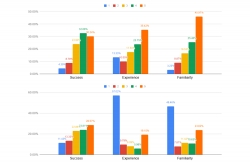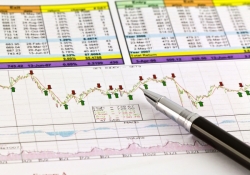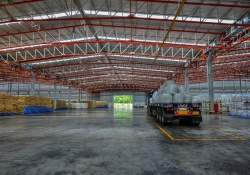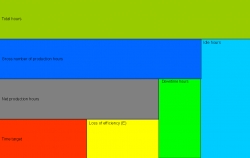When do you refurbish your supply of toothpaste at home? Do you, too, wait until the present tube is empty and then search through the drawer where there should be another tube but…
in the mess that is created, or that is already there, you can't find anything?
For heaven's sake, you were sure you saw a tube there yesterday, so where is it? You squeeze out the last bits from the empty tube and run to buy a new one. Except that this time, no one will catch you with your pants down and you buy five tubes. Just to make sure.
How long will it take you to use up five tubes? Two months? Three? What is for sure is that five tubes increase the mess of the drawer contents you had before, and now there is a good chance you won't be able to find anything when you need it.
What do you think of the following system?
Just keep one spare tube in the drawer. When the current one is finished, take out the new one, take it out of its box, but don't throw the box away. Place the empty box in the same place as your shopping list, as a reminder of what you need to buy.
By the time you use up the present tube of toothpaste, you will have bought a new tube on a routine shopping trip at the drug store or supermarket.
And don't forget, buy only one tube. If you behave this way regarding your shampoo and soap and any other groceries, it is quite likely that your drawers or storage shelves will be emptier and organized. You will always be able to easily find what is there.
Kanban
Carmel, my loving wife, calls this method "Headstones", for the empty boxes that wait for hours or days, in a safe place in the middle of the kitchen. But it does have another name, and of course, it wasn't me that invented it.
Tiichi Ohno, of Toyota, called it the Kanban method and developed it for the JIT (Just In Time) production method.
The central idea is to receive raw materials or finished product at the exact required moment, not before and not after. Just in time.
The Japanese word "Kanban" has a number of meanings, and the relevant one for this case is card. Let's look at the idea and origin of the name.
Let's suppose we have a brief production chain of four stations: customer, production station, warehouse and supply, as in the following illustration:

- At the production station, we keep one product for the customer and a drawer with the components for additional production if necessary.
- The customer pulls finished product from the production station.
- The employee at the production station takes raw materials from the drawer and manufactures new product. Simultaneously, he forwards the empty drawer to the warehouse with an ID card that identifies the contents that were in the drawer.
- In the warehouse is a drawer ready with the intended raw materials, which the warehouse employee pushes into production.
- Simultaneously, the warehouse employee forwards an order according to the ID card to the supplier of a new drawer of raw materials for the warehouse.
Both the number of boxes and the two-directional arrows in the diagram are intentional, to emphasize that we are working with the pull method and not the push. Meaning, the customer pulls from production, production pulls from the warehouse, which pulls from the supplier. This method is sometimes also called the Drawer Method.
What if we are talking about a more complicated chain of production or a retail network that imports, say, from China?
In the case of a more complicated chain of production, we will conduct ourselves in the same way, where each production station will be the customer for the production station before it in the chain and the supplier of the station after it. Just add customers and production stations to the diagram as needed.
In the case of a retail network that imports from China (or anywhere else), we do the same thing, but we take into account the supply time and store a sufficient quantity of "drawers" of raw materials (or imported product) in the warehouse.
The appropriate quantity is the quantity we would consume from the time we issue our order until we get our supply from China (or wherever).
An example of working by the Kanban method when the supplier is in China
Last year, Bracha called me and asked for a recommendation on stock management software for her small, at-home business. Bracha purchases parts from China and manufactures gifts.
She says there are a lot of parts and she can't always remember when it's time to order more of each type. As a result, when she runs out of a specific part, she has to wait until she gets her entire shipment of parts from the Chinese manufacturer.
Bracha's business is small and stock inventory software is too expensive for her. Nor does she need it.
I recommended to Bracha that she work according to the Kanban method: to store the parts in standard drawers, with a known quantity in each drawer.
So let's say that each week Bracha uses up 25 parts, and supply time from China is 4 weeks. That means that during those 4 weeks of waiting for the next delivery of parts, Bracha uses up a total of 100 parts.
To be safe, Bracha will add another week, i.e. 5 weeks, which is 125 parts.
I recommended that Bracha store 125 parts in each drawer. When she uses up everything except the last drawer of parts, she should immediately send another order to her supplier. That way Bracha can manage her small business without any need for management software.
This method is just as accurate for larger businesses, including those that utilize stock management software. The drawers, in this case, become virtual, for computer application.
How much should we order each time?
I will dedicate a separate article to this subject very soon.
I will just say for now that the necessary considerations include the cost of freight and the agreements we have with our suppliers, on the one hand, and the need to maintain "thin" stocks (remember? Just in Time), the cost of storage, and shelf-life (expiry) of stocks (particularly regarding food products, medicines, fashion, etc.), on the other.
Summary and Recommendations
The bottom line is that Just in Time Production increases profits and improves the business's cash flow.
Proper stock management, where parts and products arrive on time, not before and not after, will ensure that your stocks are in exactly the appropriate quantities. No extra stock, which creates confusion, or worse than this, no stock that expires and must be destroyed. And also, no leaving us short of product, which will result in stoppage of production and/or sales.
The Kanban method is a necessary tool for working with Just In Time processes.












 My First Book: Manage! Best Value Practices for Effective Management
My First Book: Manage! Best Value Practices for Effective Management